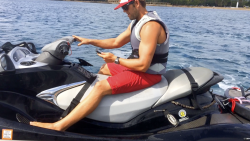Members of the North Shore Lifeguard Association (NSLA) must be prepared for the ever-changing daily conditions of life in the surf. The organization consists of more than 40 lifeguards posted on the North Shore of Oahu, world renowned for the volume and intensity of its waves. Responding to emergencies in the sun, sand and surf is serious business and can be harmful to mobile technology. The NSLA stays connected with the OtterBox Preserver Series – seriously waterproof smartphone cases.
The NSLA strives to fulfill three community-centric goals: educate people about swimming and ocean safety; host fundraising and outreach events; and administer the Junior Lifeguard program, which trains the community’s youth on basic ocean safety and life-saving skills. NSLA takes preventative action to ensure safety along a seven-mile stretch of pristine beaches. The picturesque location, coupled with world-class waves, attracts a mixture of surf enthusiasts, causal tourists and locals alike. It’s estimated that the area, with a permanent population around 20,000, sees about 3 million visitors annually.
|
North Shore Lifeguard Association |
|---|
|
NSLA was created to fulfill three goals for the community on North Shore of Oahu. Those goals are to educate the community and visitors about water safety, provide community events and outreach and support the junior lifeguard association
|
“Everybody just wants to jump in the water and go swimming,” said Donald ‘DJ’ Rogers, NSLA member and North Shore rescue operator. “People don’t understand that we have rip currents and dangerous shore break, they just see the water and sprint to it. We are pretty much here to make sure that they are safe.”
NSLA members use their OtterBox Preserver Series-equipped smartphones to stay alert of changing conditions with weather-predicting apps and tidal trackers, and they use GPS to pinpoint people who are in distress. Rogers knows first hand how knowledge of weather conditions can change the success of a rescue.
“When we are doing a search, it is really good to know if the wind is going to change, if the tides are going high, if the tides are going low, and the phone actually works really well for that,” Rogers said. “I can put it right in the middle compartment of the Jet Ski right next to me, if it gets wet I don’t have to worry about it. It’s going to be dry.”
When working in the mobile response unit, lifeguards must respond to calls in remote parts of the island. The only direct communication they have with the victims is through their phones. They will often call to pinpoint the exact location for the rescue.

“We have to call them on their cell phone with ours to find out exactly where their location is, because sometimes locations can get misconstrued through talking over the radio,” explained Mike Jutt, NSLA member and seven-year lifeguard. “It’s easier to have a direct line of communication to the person on the beach who is calling in the emergency.”
Minutes and seconds count in this line of work. When heading out to a rescue, the lifeguards don’t give much thought to their mobile devices, often leaving them in pockets or allowing them to fall out of the truck onto concrete or sand.
“The Preserver Series has protected my phone,” said Ryan Phillips, NSLA member and 10-year lifeguard. “I might be on the way to a rescue, I might forget my phone in my pocket, now I know that I can have that sense of insurance that I know my phone won’t get destroyed.”
Even on a lifeguard’s day off, his time is likely spent on the water. It’s a way of life on the North Shore. From the importance of weather apps and GPS at work to snapping photos and tracking prime fishing conditions while at play, the North Shore lifeguards bring technology along with them.
“Since I have had a Preserver Series case on my phone it has opened up some possibilities for me,” said Phillips. “I might throw it in my pocket when I swim out to get some photos of the surf with my friends or I might have it on the Jet Ski while I am at work.”
PDF Version of Case Study